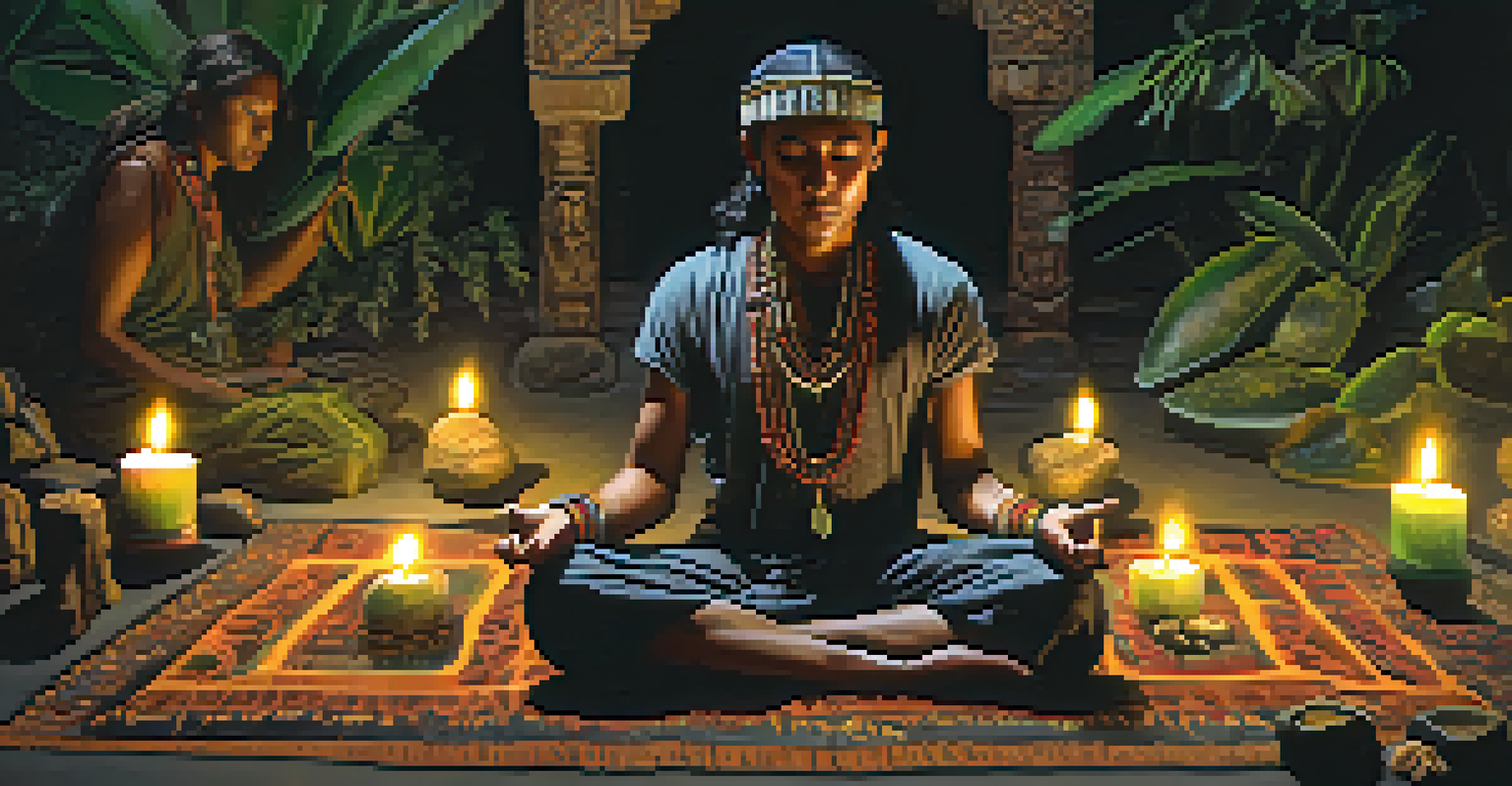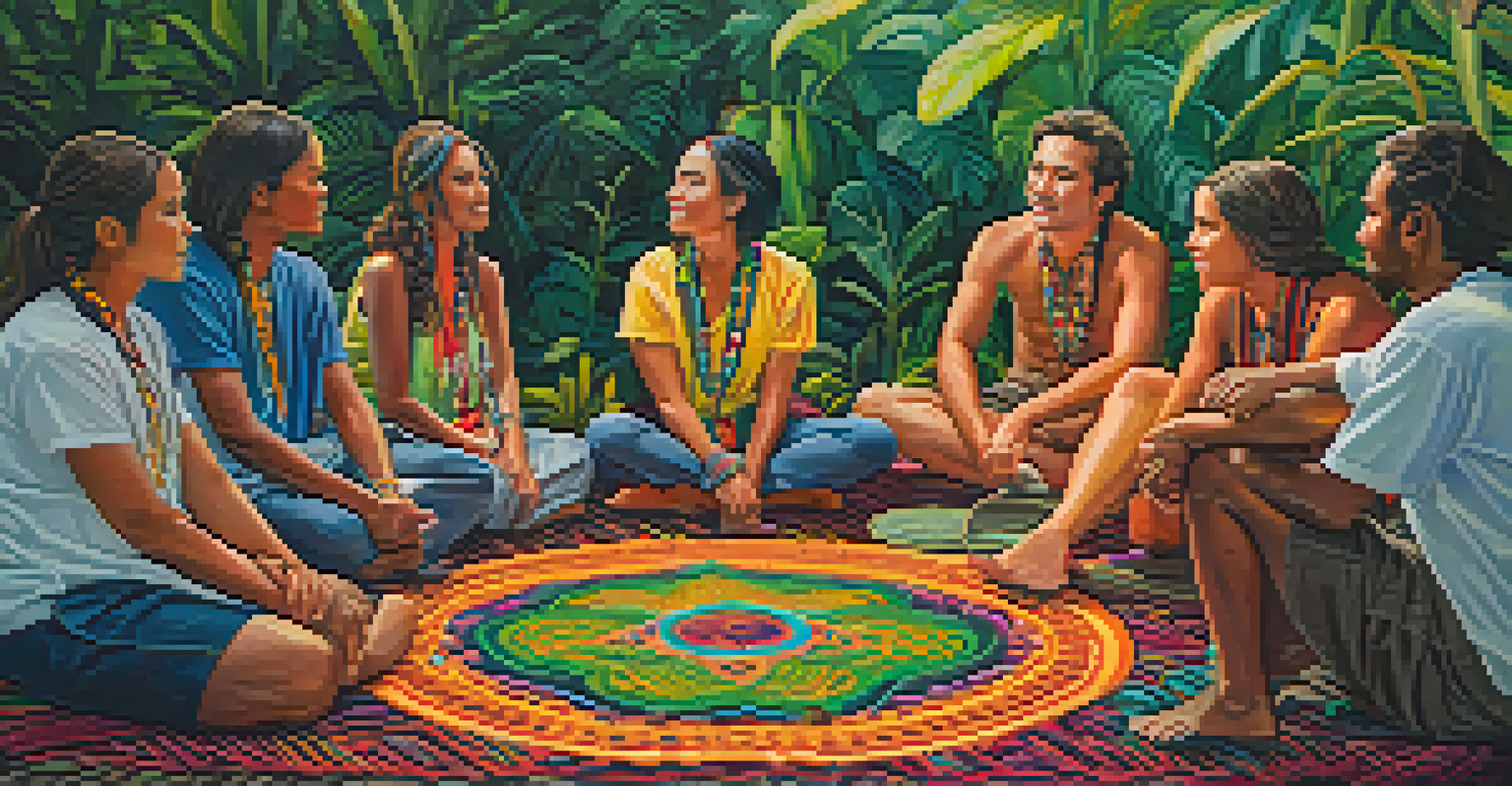Surrendering Control: Unlocking Ayahuasca's Healing Potential

Understanding Ayahuasca and Its Healing Properties
Ayahuasca is a powerful brew made from the Banisteriopsis caapi vine and other plants. It's traditionally used in Amazonian cultures for spiritual and healing purposes. The main active ingredient, DMT, is known for inducing vivid visions and deep emotional experiences that can lead to profound insights.
The greatest journey is the one within.
Many people turn to Ayahuasca in hopes of addressing mental health issues, trauma, or seeking personal growth. The experience can be intense and requires a willingness to confront one's inner self. This is where the concept of surrendering control becomes essential.
By letting go of preconceived notions and expectations, participants often open themselves to the healing potential of the experience. This surrender allows for a deeper connection with the medicine and fosters an environment for transformation.
The Importance of Surrender in the Ayahuasca Journey
Surrendering control during an Ayahuasca ceremony can be likened to letting go of the steering wheel in a car. While it might feel daunting, it allows the journey to unfold naturally. This act of surrender is crucial for participants to fully embrace the experience and the lessons it brings.

Many find that clinging to control can lead to resistance, which may hinder the healing process. When individuals allow themselves to trust the experience, they may encounter insights and emotions that were previously buried. This openness can lead to significant breakthroughs.
Surrendering is Key to Healing
Letting go of control during an Ayahuasca ceremony allows participants to fully embrace the transformative experience.
Surrendering doesn't mean abandoning all responsibility; rather, it’s about accepting the journey as it comes. This mindset can help participants navigate the intense emotional landscapes that often arise during Ayahuasca ceremonies.
Creating the Right Mindset for Healing
Before embarking on an Ayahuasca journey, it's essential to cultivate a mindset conducive to healing. This can involve practices such as meditation, journaling, or setting intentions. By reflecting on what you hope to achieve, you can create a framework for your experience.
You cannot control what happens to you, but you can control your attitude toward what happens to you, and in that, you will be mastering change rather than allowing it to master you.
An open mindset allows participants to approach the ceremony with curiosity rather than fear. Embracing this approach can help facilitate a smoother journey, as it encourages exploration of the inner self without judgment. This is particularly important when facing challenging emotions.
Additionally, connecting with a supportive community can enhance this mindset. Sharing experiences and insights with others can foster a sense of belonging and reinforce the decision to surrender control, making the healing process feel less isolating.
Challenges of Letting Go During the Experience
While surrendering control can lead to profound healing, it also comes with challenges. Many participants report moments of fear or anxiety as they confront uncomfortable emotions or vivid visions. These feelings can create a strong urge to regain control, which can disrupt the experience.
During these moments, it's essential to remember that discomfort is often a part of the healing process. Embracing these feelings rather than resisting them can lead to deeper understanding and growth. Participants can benefit from reminding themselves that surrendering is a journey, not a destination.
Mindset Shapes the Journey
Cultivating an open and curious mindset before the ceremony can significantly enhance the healing process.
Having a guide or shaman present can provide support during these challenging moments. Their experience and reassurance can help participants navigate difficult emotions, reinforcing the importance of surrender in the healing journey.
Integration: Bringing Insights Back to Daily Life
The insights gained during an Ayahuasca ceremony are often profound, but integrating these lessons into daily life is equally important. This process can be seen as a bridge between the spiritual and the mundane. It requires a commitment to applying newfound knowledge in everyday situations.
Journaling after the ceremony can be a powerful tool for integration. Writing down experiences, emotions, and insights can help clarify thoughts and reinforce lessons learned. It also provides a tangible way to reflect on the journey long after the ceremony has ended.
Engaging in regular self-care practices, such as meditation or therapy, can further support this integration process. By continuing to nurture the insights gained, participants can maintain the healing momentum and continue their personal growth.
The Role of Community in the Ayahuasca Experience
Community plays a vital role in the Ayahuasca experience, offering support and a sense of belonging. Many find that sharing their journeys with others fosters connection and understanding. This communal aspect can make the experience less daunting and more meaningful.
Supportive relationships can also provide a safe space for participants to express their feelings and insights. Engaging in discussions with others who have had similar experiences can deepen understanding and reinforce the lessons learned during the ceremony. It promotes a sense of shared healing.
Community Enhances Healing
Sharing experiences within a supportive community fosters connection and reinforces the lessons learned during the Ayahuasca journey.
In many cultures, Ayahuasca ceremonies are communal events, emphasizing the importance of collective experience. This aspect highlights that healing is not just an individual journey but one that can be enriched through connection and shared vulnerability.
Conclusion: Embracing the Power of Surrender
Surrendering control is a key aspect of unlocking Ayahuasca's healing potential. It allows participants to dive deep into their emotions and confront challenges that may have been avoided in the past. By embracing this journey, individuals can experience profound transformation.
As with any healing journey, it's essential to approach Ayahuasca with an open heart and mind. Trusting the process and allowing the experience to unfold naturally can lead to insights that extend far beyond the ceremony itself. This ongoing journey of self-discovery is where the true healing lies.

Ultimately, surrendering control invites growth and a deeper understanding of oneself. Those who are willing to embark on this journey often find themselves on a path toward greater clarity, compassion, and connection—both with themselves and others.